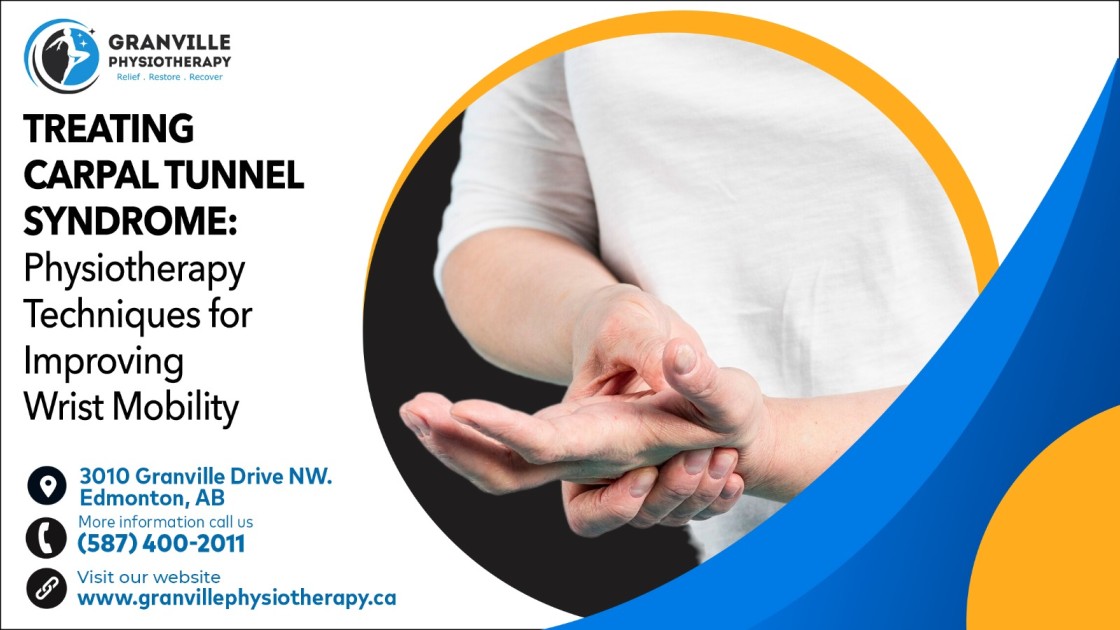NEWS
Treating Carpal Tunnel Syndrome: Physiotherapy Techniques for Improving Wrist Mobility

Carpal tunnel syndrome (CTS) arises when the median nerve, extending from the forearm into the palm of the hand, experiences compression or constriction within the carpal tunnel located at the wrist. This compression may lead to symptoms like numbness, tingling, discomfort, or weakness in the fingers and hands. Physiotherapy in Edmonton aims to improve symptoms, restore function, and halt the condition from worsening further through a comprehensive and individualized treatment approach.
Enhancing Wrist Mobility in Carpal Tunnel Syndrome: Physio Techniques:
In Edmonton, physiotherapy techniques for improving wrist mobility in treating carpal tunnel syndrome aim to alleviate pressure exerted on the median nerve and restore normal function to the wrist and hand. Here are some common techniques used:
Joint Mobilizations:
Physiotherapists may perform manual joint mobilization techniques to improve the mobility of the wrist joints. This may include gentle oscillations or sustained stretches to minimize stiffness and enhance the range of motion. Here are some commonly used techniques:
Kaltenborn-Evjenth Mobilization:
Kaltenborn-Evjenth Mobilization is named after its developers, Freddy Kaltenborn and Olaf Evjenth. The collaboration between Kaltenborn and Evjenth led to the development of a comprehensive approach to manual therapy, including specific joint mobilization techniques aimed at restoring normal joint function and improving movement patterns.
This technique involves specific joint mobilization movements performed by the physiotherapist to target restrictions in wrist mobility. The therapist applies controlled pressure to the joint surfaces to encourage improved joint motion.
Cyriax Mobilization:
Cyriax Mobilization refers to a set of manual therapy techniques developed by Dr. Cyriax for the assessment and treatment of musculoskeletal conditions. Physiotherapists may use Cyriax mobilization techniques, which involve applying sustained pressure or oscillatory movements to specific areas of the wrist joint to address restrictions and improve mobility.
Soft Tissue Mobilization:
Techniques like massage, myofascial release, or instrument-assisted soft tissue mobilization (IASTM) can help release tension in the muscles and connective tissues surrounding the wrist joint. This can reduce compression on the median nerve and improve overall wrist mobility. Here are some commonly used soft tissue mobilization techniques in physiotherapy clinics:
Massage Therapy:
Therapeutic massage involves applying various pressures and strokes to the muscles and surrounding connective tissues in the wrist joint. This helps to minimize muscle tension, maximize blood flow, and promote relaxation, which can alleviate symptoms associated with carpal tunnel syndrome and improve wrist mobility.
Active Release Techniques (ART):
ART is a soft tissue mobilization technique that involves combining movement with manual pressure to treat soft tissue injuries and improve mobility. Physiotherapists use their hands to locate and release adhesions and scar tissue present in the muscles and fascia surrounding the wrist joint, promoting a better range of motion and function.
Nerve Gliding Exercises:
Specific exercises are designed to mobilize the median nerve and its surrounding tissues, helping to alleviate compression within the carpal tunnel. These exercises involve gentle movements of the wrist and fingers to promote nerve mobility and reduce symptoms.
Median Nerve Gliding Exercise:
This exercise involves a series of coordinated movements of the wrist, fingers, and arm to gently mobilize the median nerve. It typically includes the following steps:
- Start with the arm extended straight out in front of you, palm facing down.
- Slowly flex the wrist downward (towards the floor) while simultaneously bending the elbow.
- Hold this position for a few seconds, then slowly extend the wrist upward (towards the ceiling) while straightening the elbow.
- Repeat this flexion and extension movement rhythmically, focusing on smooth and controlled motions.
- Perform the exercise for several repetitions, gradually increasing the range of motion as tolerated.
Stretching Exercises:
Targeted stretching exercises for the muscles and tendons of the wrist and forearm aid in enhancing flexibility and alleviating tension in the affected area. Stretching should be performed gently and within a pain-free range of motion to avoid exacerbating symptoms.
Wrist Flexor Stretch:
- Extend your arm straight out in front of you with the palm facing downward.
- Use your other hand to gently bend your wrist downward towards the floor.
- Maintain the stretch for 15-30 seconds, feeling a gentle stretch along the underside of your forearm.
- Repeat on the other side.
Active Range of Motion Exercises:
Physiotherapists may prescribe exercises that involve actively moving the wrist joint across its complete range of motion. This can help improve joint mobility, reduce stiffness, and promote circulation to the area.
Wrist Circles:
- Extend your arm straight out in front of you at shoulder height, palm facing downward.
- Gradually turn your wrist in a circular motion at a leisurely pace, moving through its full range of motion.
- Perform 5-10 circles in one direction, then reverse and perform 5-10 circles in the opposite direction.
Strengthening Exercises:
Strengthening the muscles surrounding the wrist joint can help stabilize the area and reduce strain on the median nerve. Physiotherapy in Edmonton provides specialized guidance on exercises specifically designed to strengthen the wrist extensors, flexors, and intrinsic hand muscles, facilitating optimal recovery from carpal tunnel syndrome.
Intrinsic Hand Muscle Strengthening:
Finger abduction with rubber band: Place a rubber band positioned around your fingers just above the knuckles. Extend your fingers apart against the resistance of the band, then release. Perform 10-15 repetitions.
Hand grip strengthening with a hand exercise ball: Hold a hand exercise ball or stress ball in your hand. Squeeze the ball as tightly as possible, then release it. Perform 10-15 repetitions.
Facilitating Rehabilitation:
Physiotherapy in Edmonton plays a vital role in the comprehensive of carpal tunnel syndrome treatment. By offering personalized treatment plans adapted to each individual’s needs and goals, Granville Physiotherapy in Edmonton provides a comprehensive approach to carpal tunnel syndrome management, promoting long-term relief and improved quality of life.
To benefit from these advantages firsthand and receive a tailored therapy program addressing your specific needs for carpal tunnel syndrome, consider searching for a “physiotherapist near me,” and it will guide you on your path toward optimal wrist health.










